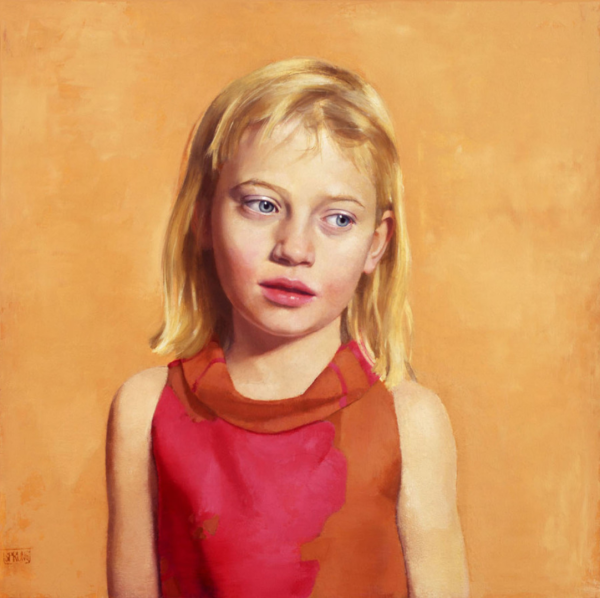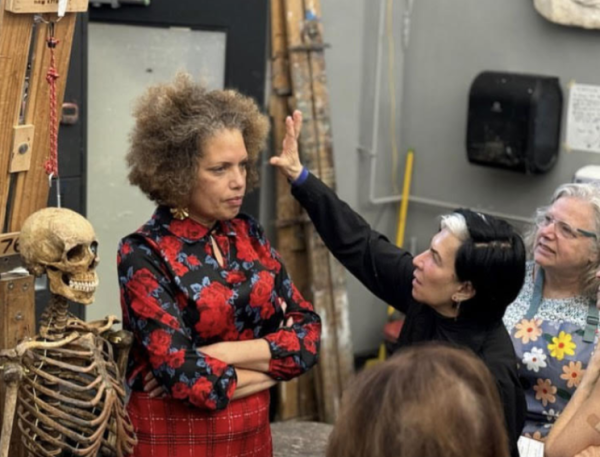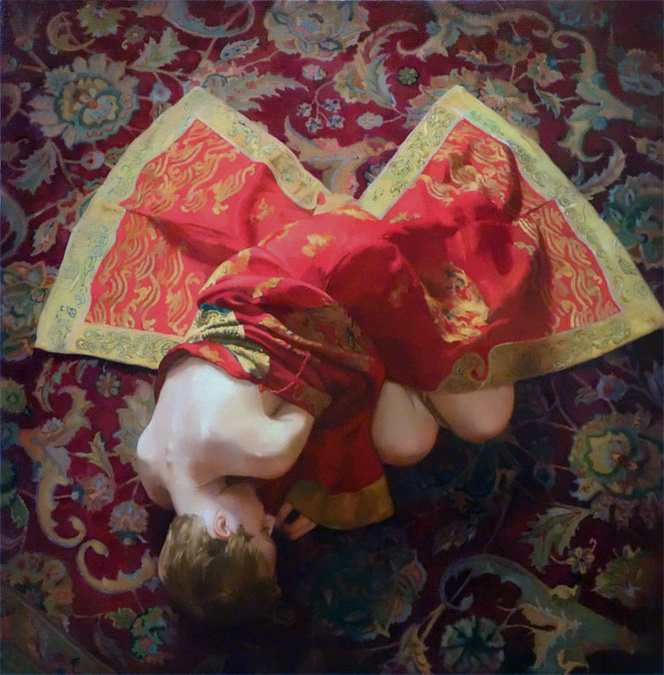In her own words, “left-handers rock.”
Upon any appropriate opportunity, Sharon Sprung will bring up the world’s bias toward lefties, more specifically, the art world. Specifically, she lists, “can openers, voting machines, ice cream scoops, slot machines, and zipping our jeans.” After she found out that I myself am left-handed, she was eager to share this list with me, with a “we lefties have to stick together” spirit.
Intuition
Before Sharon Sprung starts each painting, there are a few things that she asks of the sitter. For her own models, she takes a look at their clothing and makeup, and takes some of their hair to familiarize herself with their appearance and self. For commissioned works, she looks into the person themselves, starting off with their photos and examining the poses that they naturally tend to fall into, by looking at their past photos. Once she captures their environments, she has two photo sessions lined up.
By the end of the first session, Sprung has an idea of what she wants to do and picks out her top six favorite pictures to show the clients who commissioned her. Building a relationship with her models is key. She has them confide in her as an artist, and, on her end, she gets a beautiful relationship that she builds on and better understands, as she adds to her painting for the weeks that follow these interactions.
Then, she asks for a childhood photo.
“I think we all have a photo — or at least I do. I took a look at a photo from when I was ten. and I looked at it and said, almost in despair, ‘I haven’t changed at all.’ I’m still that impatient ten-year-old that doesn’t take to lessons well, that doesn’t listen well, that wants to go out on my own and do things my own way,” she said.
Within the period where she gets to know this other person, she matches their flesh tone through intuition. Sprung has trained herself to get this intuition, a sixth sense, that she uses to match a person and bring them to life eventually. When she gets close, the people “start to talk to” her in the painting. They say, “Oh! That’s not my eye,” Sprung said.

Sprung’s belief is that once you start to see properly, you will gain this intuition. “Once you can see,” she said, you can seamlessly match skin tones and create a person on canvas. To “see,” you practice and you develop your skills to the point of near perfection. It is the point where you can translate a model’s being onto a canvas, because you refined your abilities.
Sharon Sprung’s studio in Brooklyn, New York, doubles as her home. Where she lives is where she paints, and where she paints is where she lives. What she ends up with is a deeply personal space where she can enter a separate relationship with her paintings. As Sprung communicates more with a painting through each brushstroke, the painting begins to communicate with her in turn.
Sprung said, “I say ‘good morning’ to the people. I say ‘goodnight to the people.’ And in between, I might curse them or say ‘Ay, we’re doing good. This is good!’”
Teaching
Like many artists, her journey began at a young age. Growing up in Glen Cove, New York, she took classes at the Arts Students League (ASL) to develop her artistic interest and continues to do so as a teacher. Throughout her artistic career, she has taught at the National Academy School and ASL. Her first twenty years of teaching were at the National Academy School, and her following twenty were at ASL where she currently teaches ‘Painting From Life: Portraiture.’ Through these classes, Sprung passes on her knowledge of oil painting and portraiture to a variety of students who carry on her lessons with them as they continue in their own artistic careers — similar to the ways in which she started out.
Sprung wanted to study under Aaron Shikler soon after he did the Kennedy portraits that currently hang in the White House. She was moved by the act of creating those paintings during that period, soon after John F. Kennedy passed away. So, she sent a letter to Shikler.
She wanted to study under Harvey Dinnerstein, so she sent him a letter. The same continued with Burton Silverman and then Daniel E. Greene, and she sent them both letters.
Shikler didn’t answer the first time, Dinnerstein led her in the right direction, Silverman invited her to his private classes, and Greene sent her to his class at the National Academy. At this point, she had left Cornell University following the completion of her first year. She felt that to learn how to paint — and truly learn — she had to do so in a studio space. This was now what it meant to put herself out there and chase her ambitions.
Sprung was now faced with a fully realized passion for painting. So, she sought it out and stuck to the stubbornness of her ten-year-old self to again go out and do things her own way. “The kindness of other people, scholarships, and encouragement from teachers, like me, at the Art Students League,” she said, helped her despite her difficulty in finding jobs and cheap housing and paying for her schooling.
After years of attending the National Academy and the Art Students League at the start of her own artistic journey, she turned to teaching there, around forty years ago. This way, she continued to preserve her personal art world that had grown since her beginnings. “My life, my friendships, everything took place in those walls. It’s an honor to return to the Art Students League; it’s like my college,” she said.
Her advice to aspiring painters is the following: to be a painter, you have to make sacrifices.
“I can’t be a painter and be at a night party. That was clear to me. You make these sacrifices for your art, and most people can’t do that; you have to have the mindset,” she said. When she senses this in her own students, she encourages them and gives them what she can.
In her own classes, Sprung practices and exercises her abilities. She sparingly puts a paintbrush to her students’ work to suggest and to teach. She teaches the following: anatomy, gesture, color, light, shade, and form. Most importantly, she teaches them what she taught herself over the years, the ability to see. To see with clarity, she believes, is a language and art form on its own. Eventually, each student gets it. Sprung enters a classroom with the intention of teaching someone how to paint in the way that they will paint, not how she paints.
For the past two years, my twin sister and I have had the experience of helping out while Sharon Sprung, her monitors (who are like assistants of the class), and her students, dedicate hours to work on dozens of their collective works. As her students worked, Sprung moved from place to place, giving advice with her stark, signature black and white hair, making her easy to spot, despite it being a small space with materials and people filling from corner to corner.
But whether Sprung stands on ladders or has her feet on solid ground, it’s clear that she has command of the room. It is not from an unwavering, demanding kind of force; instead, she would look at the display, think, and then either instantly figure out what was best or, ask the people around what they thought.
After learning the ropes and figuring out how to prepare and set up all the canvases on the walls, my twin and I gained more responsibility as Sharon handed it out. It was gratifying to be trusted to do something that we had never explicitly done before and have something to do at every moment. Despite her automatic authority in that gallery room, it was her delegation and the mutual respect between her and her students that made it even more obvious why she was in charge in the first place.
Today, Sharon Sprung is most known for her paintings of a range of people. From politicians to academic representatives to single mothers, Sprung holds on to classic realism in figure painting while still making it her own; she “doesn’t want it to look like it was made in 1913.”
Sharon Sprung focuses on the experience of women and her own experiences through the portraits of others. She reasons that although her portraits are of other women, they are really self-portraits because of how she creates them and curates them to reflect her own emotions.

As part of the forefront of today’s Contemporary Realism movement, Sprung has been commissioned, most notably, as the official artist for Michelle Obama’s White House portrait. The vibrancy of the painting allows her own values to shine through. Sprung’s love of color and pattern is woven into the canvas, as each stroke is matched with a choice. The choice of dress is filled with detail in its folds, and her choice of background color is inspired by the Red Room in the White House.
Another piece included in an unordinary list of commissions is Sprung’s portrait of House Representative Patsy Mink, which was recently unveiled on June 24th, 2022. The process of Patsy Mink’s painting is a testament to Sprung’s work; Mink, the first Asian-American woman and woman of color elected to Congress, pushed to diminish sexual discrimination in education and sports.
In an effort to commemorate Patsy Mink and her work, Sharon Sprung dove head first into extensive research; she watched videos, read works, and got a look into Mink’s life and optimism. Without Mink in front of her, Sprung drew from her research in order to create a painting that embodied the former House Representative.
Sprung explains that many of her commissions largely come from women who are the first to be something in their respective fields, or the first in their families and are self-made people, with whom she compares to herself.
At the core of Sprung’s character is the extent to which she honors experiences. In the classroom, she works out her mind and is exposed to a large variety of people and experiences. It gives her a pause between her own painting sessions and provides her with valued interactions. With her commissioned work, Sprung values the “rich life” that she has built, which allows her to enter the worlds of her portrait subjects and where she can paint “firsts.” Sprung said, “I get to meet people who I would never meet. I only have a year of formal education in college, so when I’m painting people who are presidents of colleges, it’s a great honor. I really feel that walking through those halls and walking through their environment is magnificent.”
“I haven’t changed at all.”
Eventually, Aaron Shikler responded to her second letter and she visited him. Shikler, she said, said he envied how she didn’t know how a painting would turn out, how there was an entire process ahead of her. This was under the assumption that Sprung would face a similar experience in the future. But between then and now, it is not until years later that she sees a painting clearly for the first time. She continues to depend on her process, adding paint to the canvas layer-by-layer, step-by-step, as her paintings become alive and begin to speak to her once again.
To view more of Sharon Sprung’s work, click HERE.
Sharon Sprung’s studio in Brooklyn, New York, doubles as her home. Where she lives is where she paints, and where she paints is where she lives. What she ends up with is a deeply personal space where she can enter a separate relationship with her paintings. As Sprung communicates more with a painting through each brushstroke, the painting begins to communicate with her in turn.

